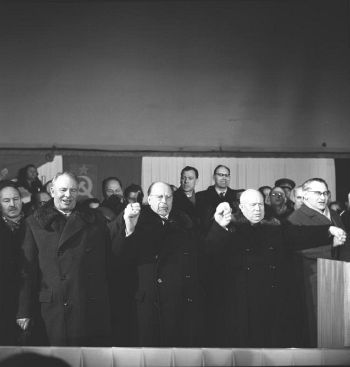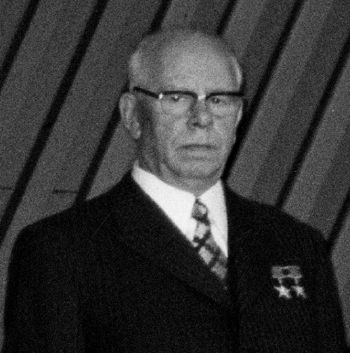Nikolai Podgorny
| Nikolai Podgorny | |
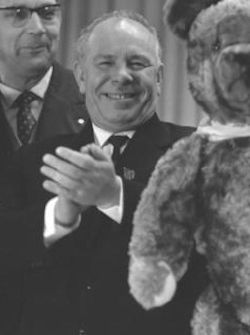 Podgorny in 1963 | |
| Preceded by | Anastas Mikoyan |
|---|---|
| Succeeded by | Leonid Brezhnev |
Second Secretary of the Communist Party of the Soviet Union
| |
| In¬†office October 14, 1964¬†‚ÄstDecember 6, 1965 | |
| Preceded by | Leonid Brezhnev |
| Succeeded by | Mikhail Suslov |
First Secretary of the Communist Party of Ukraine
| |
| In¬†office December 26, 1957¬†‚ÄstJuly 2, 1963 | |
| Preceded by | Alexei Kirichenko |
| Succeeded by | Petro Shelest |
| Born | February 18 [O.S. February 5] 1903 Karlovka, Russian Empire (now Karlivka, Ukraine) |
| Died | January 12 1983 (aged 79) Moscow, RSFSR, Soviet Union |
| Political¬†party | Communist Party of the Soviet Union (1930‚Äď1983) |
| Spouse | Natalya Nikolayevna Podgornaya (1908‚Äď1995) |
| Children | Natalia and Lesia |
| Profession | Mechanical engineer,[1] civil servant |
| Signature | |
Nikolai Viktorovich Podgorny[2] (February 18 [O.S. February 5] 1903 ‚Äď January 12, 1983) was a Soviet statesman who served as the Chairman of the Presidium of the Supreme Soviet, the head of state of the Soviet Union, from 1965 to 1977.
In 1930, Podgorny became a member of the ruling Communist Party of the Soviet Union and climbed up the Soviet hierarchy after years of service to the country's centrally planned economy. By 1953, Podgorny became Second Secretary of the Communist Party of Ukraine in 1953 before later serving as First Secretary of the Communist Party of Ukraine from 1957 to 1963.
In October 1964, Podgorny participated in a coup replacing Soviet leader Nikita Khrushchev with a troika consisting of himself, Premier Alexei Kosygin and General Secretary Leonid Brezhnev. On December 6, 1965, he replaced Anastas Mikoyan as Chairman of the Presidium of the Supreme Soviet. By June 1977, he was removed as Chairman of the Presidium as well as a member of the Politburo. Upon his removal from the Soviet leadership, Podgorny was forced to resign from active politics and sidelined in Soviet affairs until his death in 1983.
Early life
Nikolai Viktorovich Podgorny was born on February 18 [O.S. February 5] 1903 in Karlovka, Russian Empire (now Ukraine), to a Ukrainian working-class family. After the Russian Revolution in 1917, Podgorny became one of the founders of the Karlovka branch of the Komsomol, and served as a Secretary of the Komsomol from 1921 to 1923. Podgorny started work at the age of 17 as a student at the mechanical workshops in Karlovka. In 1926, Podgorny graduated from a local workers' school. In 1930, Podgorny became a member of the All-Union Communist Party (Bolsheviks), the ruling party of the Soviet Union.
In 1931, Podgorny graduated from the Kyiv Technological Institute of Food Industry and started working in the sugar industry. Podgorny was promoted to deputy chief engineer of Vinnytsia in 1937 and was promoted in 1939 as the chief engineer of the Kamenetz-Podolsk Oblast sugar trusts. By the end of 1939, Podgorny had become Deputy People's Commissar for Food Industry of the Ukrainian Soviet Socialist Republic (Ukrainian SSR). The next year, Podgorny was appointed Deputy People's Commissar for Food Industry of the Soviet Union.[3]
Rise to the Soviet leadership (1942‚Äď1964)
Podgorny became the Director of the Moscow Technological Institute of Food Industry in 1942 during World War II. After the liberation of Ukraine from Nazi Germany, Podgorny reestablished Soviet control over Ukraine on the orders of the Ukrainian SSR and the Soviet Government. In the post-war years, Podgorny regained his old office of Deputy People's Commissar for Food Industry of the Ukrainian SSR, but was later appointed in 1946 as a Permanent Representative to the Council of Ministers of the Ukrainian SSR. In April 1950, he was made First Secretary of the Kharkiv Regional Committee of the Communist Party of Ukraine (CPU). In 1953, Podgorny was elevated to Second Secretary of the Central Committee (CC) of the CPU. From 1957 to 1963, Podgorny was First Secretary of the CC of the CPU, effectively the most powerful position in Ukraine. In this role, Podgorny worked on reorganizing and modernizing the Ukrainian economy, which had been destroyed during the war years. He worked to increase the rate of industrial and agricultural production and to improve people's welfare. He paid particular attention to improving party organization and educating new cadres.[3]
In 1960, Podgorny became a member of the Politburo (Political Bureau), the highest policy-making authority in the Soviet Union. By 1963, Podgorny had risen to prominence within the Soviet hierarchy as a member of the Secretariat of the Communist Party of the Soviet Union (CPSU). As a protégé and close companion of Soviet leader Nikita Khrushchev, he traveled with him to the United Nations headquarters in 1960. Podgorny acted as a Soviet emissary to Czechoslovakia, East Germany, Canada, and Yugoslavia. Podgorny's beliefs were strongly influenced by Khrushchev, and under Leonid Brezhnev's rule, Podgorny was one of the most liberal members within the Soviet leadership, even more liberal than Premier Alexei Kosygin.[4]
Podgorny briefly fell out of Khrushchev's favor in 1961 when he blamed bad corn yields in the Ukrainian SSR on "bad weather," while Khrushchev claimed the crops had been "stolen" and "pilfered."[5] However, in 1962, Podgorny reported to Khrushchev that agricultural output had again increased: Under Podgorny's leadership, the Ukrainian SSR had doubled Ukraine's supply of grain to the state from the previous year. Because of his handling of agriculture, First World commentators saw Podgorny as one of Khrushchev's many potential heirs.[5]
According to historian Ilya Zemtsov, the author of Chernenko: The Last Bolshevik: The Soviet Union on the Eve of Perestroika, Brezhnev began starting a conspiracy against Khrushchev when he found out that he had chosen Podgorny, and not himself, as his potential successor.[6] During the 1964 ouster to remove Khrushchev as First Secretary and Premier, Podgorny and Brezhnev appealed to the Central Committee, blaming Khrushchev for economic failures and accusing him of voluntarism and immodest behavior. Influenced by Brezhnev and his allies, Politburo members voted to remove Khrushchev from office.[7]
Post-Khrushchev troika (1964‚Äď1977)
Struggle for power
In the aftermath of Khrushchev's removal, a collective leadership known as a troika was formed, headed by Brezhnev as First Secretary, Alexei Kosygin as head of government, and Anastas Mikoyan as head of state.[8]
Before becoming head of state, Podgorny served as the party's Second Secretary, which put him in charge of the Party's Organizational Division. In this capacity, Podgorny threatened Brezhnev's position as First Secretary because the Organizational Division, if Podgorny chose so, could easily be turned into his own power base within the party. Due to this risk, Brezhnev allied himself with Alexander Shelepin, the KGB chairman, to oppose both Podgorny and Kosygin.[9]
Podgorny's position was constantly threatened by Brezhnev and his allies. In an article in Ekonomicheskaya Gazeta (Economic Gazette) from February 1965, the newspaper criticized the Kharkiv Party organization, which Podgorny had previously headed, and its management of the economy. By indirectly criticizing Podgorny, the article raised doubts about his qualifications as a leading member of the Soviet leadership. Podgorny launched a counterattack in his 1965 speech in Baku, Azerbaijani Soviet Socialist Republic, where he criticized the Soviet leadership's heavy industrial policy. This, as it turned out, would be a move he would regret for life. Instead of offending just Brezhnev and Shelepin, he offended the whole conservative wing of the leadership. To make matters even worse for Podgorny, Mikhail Suslov, who had kept outside of the conflict, sided with Brezhnev, and called Podgorny's views "revisionist."[10]
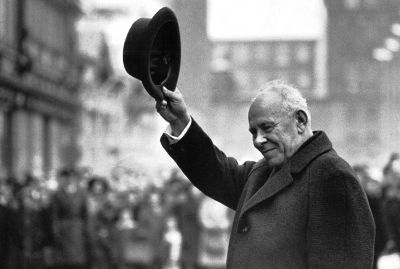
The majority of Politburo members under Brezhnev were conservative communists. Even so, Podgorny remained one of the most liberal-minded members in the Era of Stagnation. Other liberal-minded Politburo members included Kosygin and Andrei Kirilenko.[11] Factionalism within the Soviet leadership in the 1960s led Podgorny to become more active. He held several speeches in Moscow and went on numerous state visits at the expense of Brezhnev and Kosygin's popularity. Later in December 1965, Podgorny relinquished his seat in the Secretariat, taking Mikoyan's place as Chairman of the Presidium of the Supreme Soviet. According to Ilya Zemstov, his departure from the Secretariat signaled the end of his wish to assume the First Secretaryship.[12]
Still, there was speculation in Soviet society that Podgorny was trying to replace Kosygin as Premier, or even Brezhnev as General Secretary, due to his increasing presence in the late 1960s. After Kosygin's standing was damaged in the wake of the Prague Spring crisis in 1968, Podgorny emerged as the second-most powerful figure in the country behind Brezhnev.[13] In 1971, the 24th Party Congress affirmed Brezhnev's and Kosygin's status as the leadership's current highest-ranking figures. Thereafter, his influence over policy declined as Brezhnev consolidated his control over the regime, but Podgorny nevertheless showed that he remained a major player in Soviet politics by leading delegations to China and North Vietnam later that year.[14] As Brezhnev adopted more liberal positions, Podgorny attracted support among hardline communists by opposing his conciliatory stance towards Yugoslavia, disarmament deals with the West, and pressuring of East Germany into conceding to the Berlin negotiations.[15] In the Politburo, Podgorny could count on the support of Gennady Voronov and Petro Shelest. Additionally, when Podgorny and Kosygin actually agreed on something Brezhnev would find himself in the minority, and forced to accept their decisions. However, such opportunities were infrequent as Podgorny regularly found himself in conflict with Kosygin over policy issues.[16] Ultimately, the collective leadership was rendered powerless in the late 1970s when Brezhnev achieved all but complete control over the Politburo.[17]
Diplomatic protocol as head of state
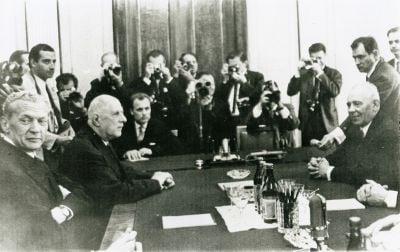
In 1967, just before the outbreak of the Six-Day War, Podgorny delivered an intelligence report to Egyptian Vice President Anwar Sadat which claimed, falsely, that Israeli troops were massing along the Syrian border.[18] That same year, he engaged in a dialogue with Pope Paul VI as part of the pontiff's ostpolitik; the result was greater openness for the Roman Catholic Church in Eastern Europe.[19] In 1971 Podgorny went on two state visits, the first to the People's Republic of China (PRC) and the second to North Vietnam. Kosygin went on a visit to Canada while Brezhnev visited Yugoslavia. Podgorny frequently paid visits to North Vietnam during the Vietnam War to discuss Soviet-Vietnamese foreign relations.[20] In 1973, Podgorny visited Finland and Mohammed Daoud Khan's Afghanistan.[21]
Brezhnev conspired to oust Podgorny as early as 1970. The reason was simple: Brezhnev was third, while Podgorny was first in the ranking of Soviet diplomatic protocol. Since September 1970 Brezhnev tried to form an opposition in the Politburo to oust Podgorny. According to Time, "There was some speculation in Moscow" that if Brezhnev didn't succeed in removing Podgorny he would establish a Council of State modeled after institutions found in, for example, East Germany (Staatsrat), People's Republic of Bulgaria and the Socialist Republic of Romania. The post of Chairman of the Council of State would give Brezhnev the top state and party job in the USSR. Brezhnev's backers were unable, and did not even try, to remove Podgorny from the head of state post at the 1970 Central Committee plenum. Brezhnev could count on only five votes, while another seven Politburo members were opposed to granting Brezhnev more power. Under such circumstances, removing Podgorny would be condemned among the Soviet elite for violating the principle of collective leadership which they had embraced after the ouster of Khrushchev.[15]
Later tenure
In the early 1970s, Brezhnev strengthened Podgorny's position at the expense of Premier Kosygin by giving the Presidium executive powers. As a result of these changes, the post of Chairman of the Presidium changed from a largely honorary office to the second most important office in the USSR. Pleased by the extension of powers given to the Supreme Soviet, Podgorny saw little threat to his position, even if a Central Committee resolution from 1971 had called for the expansion of Party activities in the Soviets.[22]
Unbeknownst to Podgorny, Brezhnev felt threatened by his new authority and ordered Konstantin Chernenko to review the 1936 Soviet Constitution for a way to weaken Podgorny's position.[23] As it turned out there were none under current Soviet law. As the head of state, Podgorny could block any measures taken by Brezhnev to circumscribe his powers. Chernenko's solution to this dilemma was to make it law that the Party leader could also become the Chairman of the Presidium. Consequently, a new constitution was drafted to include the new provision. On October 7, 1977, the 1977 Soviet Constitution which affirmed the Party's supremacy in Soviet society was approved by the Soviet leadership. The approval of the 1977 Soviet Constitution is considered Podgorny's political death knell.[24]
Removal
Podgorny's removal from office in 1977 has become the most notable example of power transfer in the late Brezhnev Era.[25] According to Robert Vincent Daniels, Podgorny was, before his removal, the second most powerful man in the Soviet Union, behind Brezhnev but ahead of Premier Kosygin. Though there were some Sovietologists who foresaw Podgorny's fall, the decision to remove Podgorny from the Politburo took the world by surprise. On May 24, 1977, a unanimous vote was taken by the Central Committee after Grigory Romanov proposed removing Podgorny from the Politburo. The vote seemed to have taken Podgorny by surprise, and immediately after the vote, he got up from his Politburo seat to instead sit with the ordinary members. Podgorny was nominally still Chairman of the Presidium, but his leadership had ended. After his removal from the Politburo Podgorny's name disappeared from Soviet media. The Soviet media told the Soviet people that he had retired due to his stance against détente and producing more consumer goods. Twenty-three days after his removal from the Politburo, Podgorny lost his Chairmanship of the Presidium on June 16, 1977.
Due to his advanced age, Brezhnev was regarded as too old to carry out some of the functions of head of state. The Supreme Soviet, on Brezhnev's orders, established the new post of First Deputy Chairman of the Presidium of the Supreme Soviet, an office equivalent to the post of Vice President. Vasili Kuznetsov, at the age of 76, was unanimously approved by the Supreme Soviet as First Deputy Chairman of the Presidium.[26]
Retirement and death
Podgorny's life after his resignation is not well documented. The last mention of him in any major Soviet media was his meeting with Urho Kekkonen, the President of Finland. There was never any explanation given, nor a denunciation of him, by the Soviet authorities.[27] Podgorny retained his seat in the Supreme Soviet after his downfall. He was seen at the 61st anniversary reception of the October Revolution at the Grand Palace of the Kremlin in November 1978 by Tokichiro Uomoto, the Japanese Ambassador to the Soviet Union. Podgorny spoke to Brezhnev, Kosygin, and then to Andrei Gromyko, all of whom looked embarrassed by the presence of Podgorny, according to Uomoto. Soon after this incident, Podgorny lost his seat in the Supreme Soviet. In the Tretyakov Gallery, Podgorny was removed from the 1977 painting of the Soviet leaders at the Red Square by Dmitry Nalbandyan in which Podgorny stood between Brezhnev and Kosygin.[28] Podgorny died of cancer in Kyiv on January 12, 1983, and was buried in Moscow at the Novodevichy Cemetery.[3]
Legacy
As with many other high-standing Soviet officials, Podgorny was honored with several awards. He was awarded five Orders of Lenin, one Order of the Red Banner and several medals, as well as several foreign state prizes by Bangladesh, the People's Republic of Bulgaria, the Mongolian People's Republic, the Czechoslovak Socialist Republic, and Finland.[3]
Notes
- ‚ÜĎ David A. Law, Russian Civilization (New York, NY: Ardent Media, 1975, ISBN 0842205292), 214.
- ‚ÜĎ Ukrainian: –ú–ł–ļ–ĺ–Ľ–į –í—Ė–ļ—ā–ĺ—Ä–ĺ–≤–ł—á –ü—Ė–ī–≥–ĺ—Ä–Ĺ–ł–Ļ, Mykola Viktorovych Pidhornyy
Russian: –Ě–ł–ļ–ĺ–Ľ–įŐĀ–Ļ –í–łŐĀ–ļ—ā–ĺ—Ä–ĺ–≤–ł—á –ü–ĺ–ī–≥–ĺŐĀ—Ä–Ĺ—č–Ļ, Russian pronunciation: [n ≤…™k…źňąlaj ňąv ≤ikt…ôr…ôv ≤…™t…ē p…źdňągorn…®j] - ‚ÜĎ 3.0 3.1 3.2 3.3 "ru:–ü–ĺ–ī–≥–ĺ—Ä–Ĺ—č–Ļ –Ě–ł–ļ–ĺ–Ľ–į–Ļ –í–ł–ļ—ā–ĺ—Ä–ĺ–≤–ł—á, War Heroes. Retrieved April 25, 2023.
- ‚ÜĎ Law, 223.
- ‚ÜĎ 5.0 5.1 "The Leading Contenders to Succeed a Tired Khrushchev," Time, June 29, 1962, 2. Retrieved April 25, 2023.
- ‚ÜĎ Ilya Zemtsov, Chernenko: The Last Bolshevik: The Soviet Union on the Eve of Perestroika (New Brunswick, NJ: Transaction Publishers, 1989, ISBN 0887382606), 74. Retrieved April 25, 2023.
- ‚ÜĎ William Taubman, Khrushchev: The Man and His Era (New York, NY: W. W. Norton & Co., 2003, ISBN 0393051447), 5. Retrieved April 25, 2023.
- ‚ÜĎ Taubman, 16.
- ‚ÜĎ Zemtsov, 87.
- ‚ÜĎ "Revisionism" in Soviet parlance was tantamount to a betrayal of Marxist-Leninist principles.
- ‚ÜĎ Law, 211.
- ‚ÜĎ Zemtsov, 88, 105.
- ‚ÜĎ "170. Memorandum From the President's Assistant for National Security Affairs (Kissinger) to President Nixon," U.S. State Department, April 10, 1971. Retrieved April 25, 2023.
- ‚ÜĎ Law, 211-212.
- ‚ÜĎ 15.0 15.1 "Soviet Union: Whoa, Comrade Brezhnev," Time, December 6, 1971, 1. Retrieved April 25, 2023.
- ‚ÜĎ Zemtsov, 103.
- ‚ÜĎ Law, 169.
- ‚ÜĎ Russell J. Leng, Bargaining and learning in recurring crises: the Soviet-American, Egyptian-Israeli, and Indo-Pakistani rivalries (Ann Arbor, MI: University of Michigan Press, 2000, ISBN 0472067036), 152. Retrieved April 25, 2023.
- ‚ÜĎ "Paul VI invites Communist Podgorny to the Vatican," Tradition in action, January 1967. Retrieved April 26, 2023.
- ‚ÜĎ Law, 429.
- ‚ÜĎ Law, 212.
- ‚ÜĎ Zemtsov, 97.
- ‚ÜĎ Zemtsov, 118.
- ‚ÜĎ Zemtsov, 119.
- ‚ÜĎ Robert Vincent Daniels, Russia's Transformation: Snapshots of a Crumbling System (Lanham, MD: Rowman & Littlefield, 1998, ISBN 0847687090), 35-39.
- ‚ÜĎ "Soviet Union: Veep in Moscow," Time, October 17, 1977. Retrieved April 27, 2023.
- ‚ÜĎ Daniels, 37.
- ‚ÜĎ Hiroshi Imai, Mosukuwa Tokuhain Houkoku (Tokyo, JN: Iwanami Shoten, 1985, ISBN 978-4004202998), 26‚Äď29.
ReferencesISBN links support NWE through referral fees
- Daniels, Robert Vincent. Russia's Transformation: Snapshots of a Crumbling System. Lanham, MD: Rowman & Littlefield, 1998. ISBN 0847687090
- Imai, Hiroshi. Mosukuwa Tokuhain Houkoku. Tokyo, JN: Iwanami Shoten, 1985. ISBN 978-4004202998
- Law, David A. Russian Civilization. New York, NY: Ardent Media, 1975. ISBN 0842205292
- Leng, Russell J. Bargaining and learning in recurring crises: the Soviet-American, Egyptian-Israeli, and Indo-Pakistani rivalries. Ann Arbor, MI: University of Michigan Press, 2000. ISBN 0472067036
- Taubman, William. Khrushchev: The Man and His Era. New York, NY: W. W. Norton & Co., 2003. ISBN 0393051447
- Zemtsov, Ilya. Chernenko: The Last Bolshevik: The Soviet Union on the Eve of Perestroika. New Brunswick, NJ: Transaction Publishers, 1989. ISBN 0887382606
Credits
New World Encyclopedia writers and editors rewrote and completed the Wikipedia article in accordance with New World Encyclopedia standards. This article abides by terms of the Creative Commons CC-by-sa 3.0 License (CC-by-sa), which may be used and disseminated with proper attribution. Credit is due under the terms of this license that can reference both the New World Encyclopedia contributors and the selfless volunteer contributors of the Wikimedia Foundation. To cite this article click here for a list of acceptable citing formats.The history of earlier contributions by wikipedians is accessible to researchers here:
The history of this article since it was imported to New World Encyclopedia:
Note: Some restrictions may apply to use of individual images which are separately licensed.
